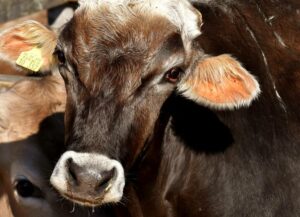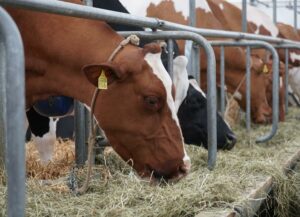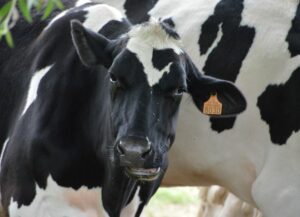María Villagrasa & Nuria García
Neonatal diarrhea is a common problem that affects newborn calves, especially during the first 28 days of life. It is of significant economic impact due to mortality, reduced growth rates, treatment costs, etc.
Diarrhea is caused by a combination of infectious and predisposing factors. Among the first we find viral, bacterial or protozoal infections, and as predisposing factors immune status or management (facilities, feed, etc.).
During an episode of diarrhea, the calf loses large amounts of water and electrolytes which makes the animal weak and unable to stand.
Supplementation with a rehydrating solution is considered the most reliable treatment to compensate for electrolyte losses and balance the acid-base status of the affected animals. However, some studies have indicated that in calves with diarrhea, feeding with combined rehydration and milk solutions may worsen the diarrhea due to a faster passage from the abomasum.
One method to determine abomasum emptying is the acetaminophen absorption test. Acetaminophen is an oral analgesic and antipyretic common in human medicine that is absorbed into the small intestine. The apparent rate of absorption is known to be much faster than the rate of elimination in neonatal calves. The maximum concentration of acetaminophen and the time required until the maximum concentration is obtained after ingestion depends mainly on the emptying speed of the abomasum.
Therefore, the objective of a study (Hildebrandt et al., 2020) was to compare the emptying rate of the abomasum by testing acetaminophen in healthy calves compared to those with diarrhea. Oral rehydration (SRO) solutions are the treatment of choice for calves with diarrhea, so their influence on the emptying rate was also analyzed.
The study was conducted with 60 pre-weaned Holstein calves aged 3-14 days. With the exception of the day of the test, all animals were fed twice daily with 4 liters of milk replacer (skim milk and whey protein) containing 50 mg of acetaminophen/kg of body weight. The calves were divided in four groups:
- Healthy calves
- Healthy calves fed an additional 75 g of SRO (healthy-SRO)
- Calves with diarrhea
- Calves with diarrhea fed an additional 75 g of SRO (diarrhea-SRO)
Blood samples were taken 30 minutes before feeding for the next eight hours at 30-minute intervals, and the last four hours at 60-minute intervals.
Vital parameters
Vital parameters were not different between calves with and without diarrhea. All calves with diarrhea tested positive for diarrhea-causing pathogens. Cryptosporidium parvum and rotavirus were the most common pathogens.
Blood electrolyte test
Diarrhea caused significant changes in the blood buffering system, such as bicarbonate, which had a lower concentration in the groups with diarrhea (27.4 mmol/l) and diarrhea-SRO (28.9 mmol/l) compared to the other groups (healthy: 31.1 mmol/l and healthy-SRO: 33.3 mmol/l).
Blood pH was also lower in the diarrhea group (7.34) compared to the healthy (7.40) and healthy-SRO (7.39) groups. These results confirmed the existence of a poor acid-base balance at least in calves with diarrhea.
Total plasma protein and changes in plasma volume
Changes in total plasma protein concentrations and plasma volume calculations are also used as tools to describe abomasum emptying.
In general, calves in the diarrhea group had lower concentrations of total plasma protein. With regards to changes in plasma volume in healthy calves, an increase in the starting value was observed at 210 min. In the group of healthy-SRO the volume was different from the initial at 180 min. Changes in plasma volume in the groups with diarrhea and diarrhea-SRO increased from the initial concentrations to 300 min.
These results indicate that changes in plasma volume were faster in healthy and healthy-SRO than in groups of calves with diarrhea, which may reflect impaired emptying rate.
Acetaminophen test results to determine abomasum emptying rate
The most relevant findings were:
- The mean maximum concentrations of acetaminophen did not reveal significant differences between groups.
- Differences were found in the mean-time required to reach the maximum concentration of acetaminophen, which was significantly higher in the diarrhea-SRO (390 min) than in the healthy (270 min), healthy-SRO (300 min) and diarrhea (300 min) groups.
- The mean half-life (half-life) of acetaminophen in the abomasum was longer in the diarrhea-SRO (652 min) than in healthy (482 min) and healthy-SRO (465 min) groups.
- The mean area under the curve of healthy calves at 120 and 240 minutes after milk replacer intake, was significantly greater than that of the groups with diarrhea.
- After 720 min of the sampling period, the mean concentrations of acetaminophen did not reach baseline values in any group.
The fact that the maximum concentrations of acetaminophen had similar values and that its peaks reached their maximum later in the diarrhea-SRO group, compared to the healthy groups indicate that a delay in the emptying of the abomasum was more likely to occur rather than reduction of the absorption capacity of the small intestine.
Evaluation of the rehydrating solution
In this study, rehydration solutions did not delay the emptying rate of the abomasum in healthy calves, as no significant differences were observed between their indexes. However, in the diarrhea-SRO group, the half-life of abomasum acetaminophen was prolonged compared to the other three groups.
Therefore, the data support the hypothesis that the mixture of hypertonic SRO with milk replacer alters the emptying rate of the abomasum, at least in calves with diarrhea. Since the abomasum emptying was delayed in calves with diarrhea, it is recommended to offer small meals to avoid abomasum congestion.
Conclusion
In calves with diarrhea there is a delay in abomasum emptying. In addition, hypertonic SRO tends to affect the emptying rate, which should be considered when feeding animal with diarrhea.
Reference
Hildebrandt T, Scheuch E, Weitschies W, Schneider F, Grimm M, Bachmann L, Vervuert I. Abomasal emptying rate of diarrhoeic and healthy suckling calves fed with oral rehydration solutions. J Anim Physiol Anim Nutr (Berl). 2020 Mar;104(2):462-469. doi: 10.1111/jpn.13306. Epub 2020 Jan 13. PMID: 31943416.
© 2021 Dairy Knowledge Center. All Rights Reserved.











